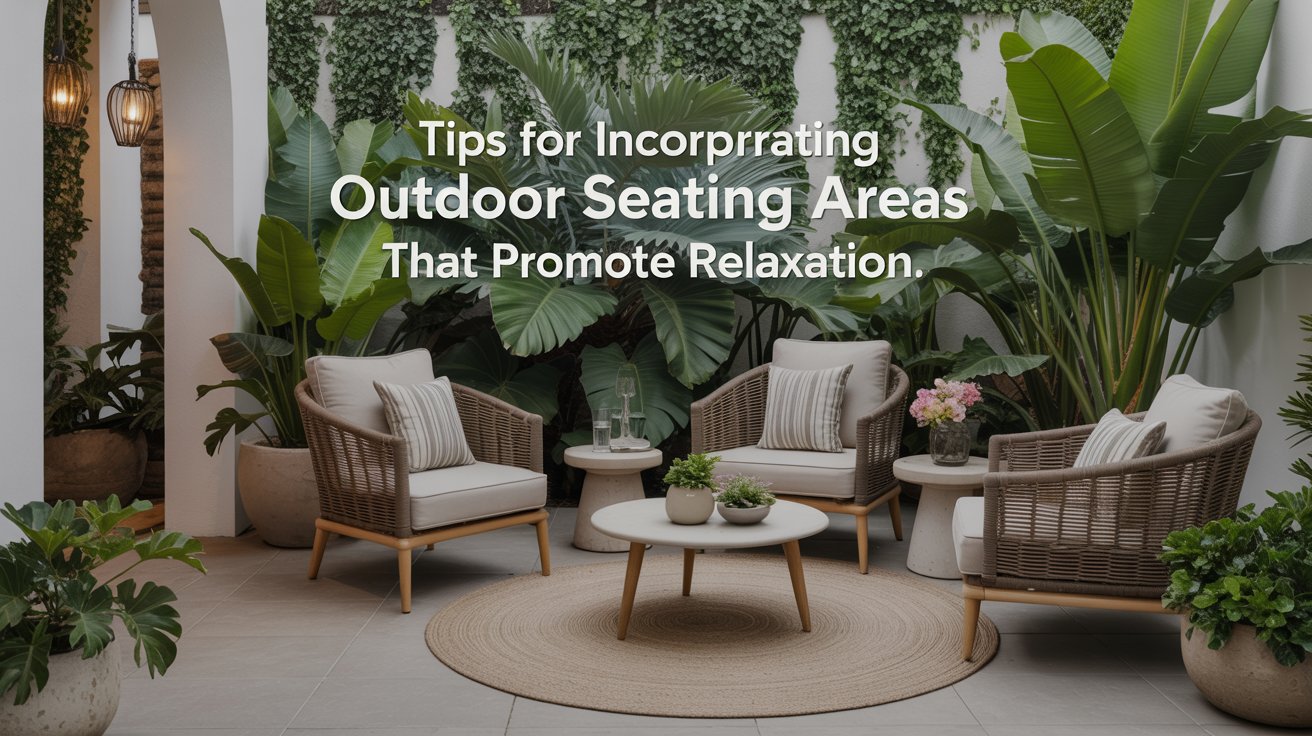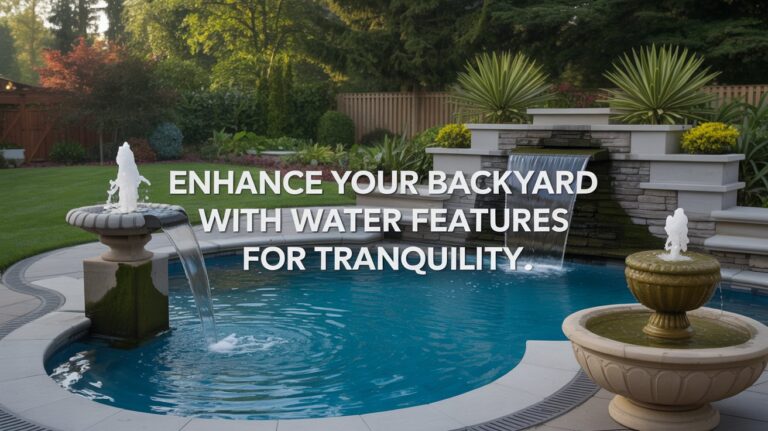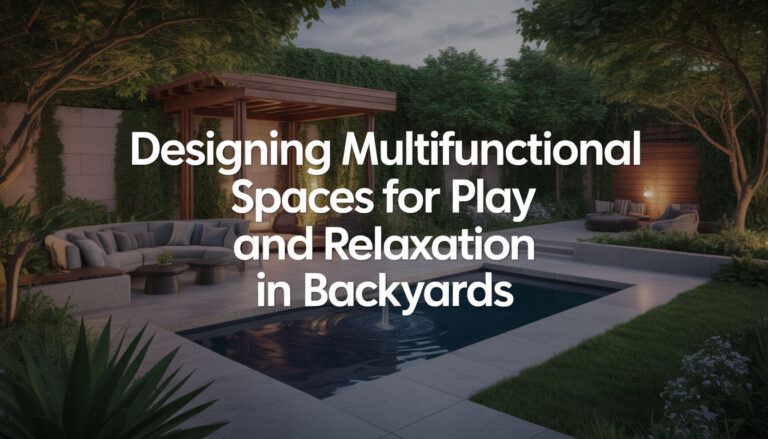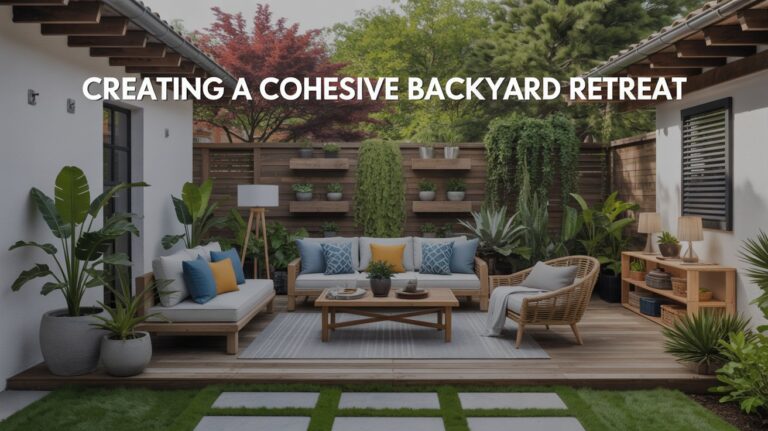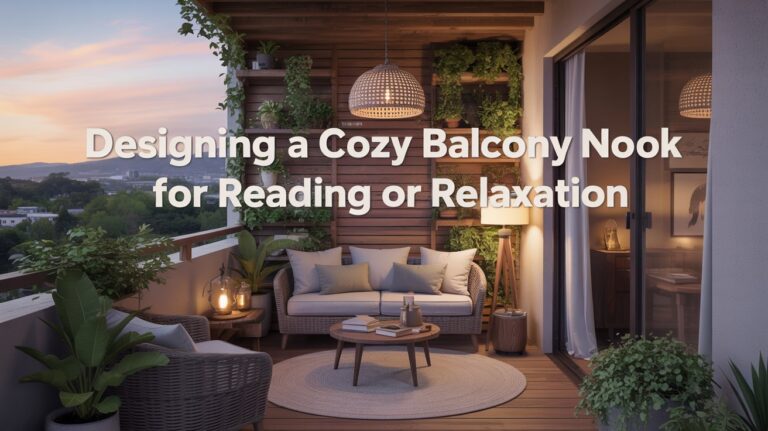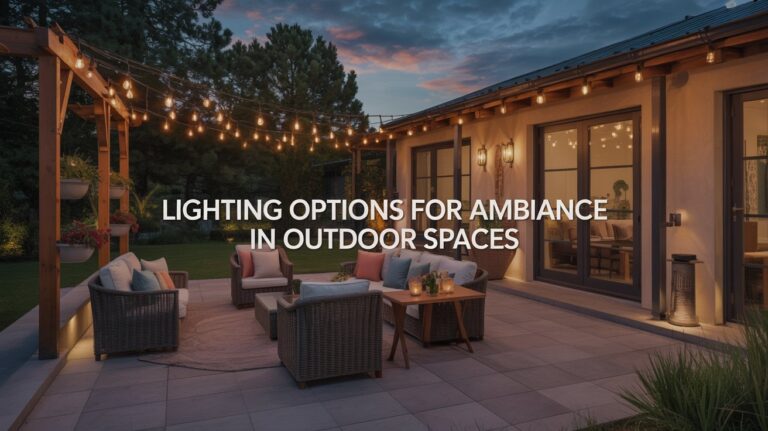Tips for Incorporating Outdoor Seating Areas That Promote Relaxation
I have been, or can be if you click on a link and make a purchase, compensated via a cash payment, gift, or something else of value for writing this post. As an Amazon Associate, I earn from qualifying purchases. Please read my full Affiliate Disclosure for more information.
To promote relaxation, select weather-ready materials and a cohesive, soft palette that stays calm over time. Opt for weatherproof frames, quick-dry cushions, and protective covers, then layer textures from woven fibers to weathered wood in gentle hues. Layer shade to reduce glare and heat while preserving sightlines, and place seating for slow, mindful conversation. Introduce greenery to frame views and soften edges, plus subtle lighting to guide calm movements. If you want more, there’s a quiet path forward beyond this.
Key Takeaways
- Prioritize a calm color palette with natural hues, textures, and cohesive accents across cushions, planters, and art to unify the space.
- Layer shade and light using permeable canopies, sails, and warm low lighting to create gentle, inviting focal points.
- Use ergonomically designed seating with supportive cushions and adjustable options for lasting comfort and posture alignment.
- Integrate pathways and greenery to frame views, slow movement, and reduce noise while connecting seating zones.
- Incorporate durable, weather-resistant materials and subtle boundaries to maintain serenity and low maintenance year-round.
Choosing Weather-Ready Materials and Finishes
Choosing weather-ready materials and finishes starts with anticipating exposure. You’ll assess sun, rain, and humidity patterns, then select fabrics, woods, and metals that resist deterioration. For dining furniture, opt for corrosion-resistant frames and fade-stable cushions, paired with quick-dry foams. Sealants and finishes should tolerate temperature swings without cracking, peeling, or chalking. Consider protective coatings and removable, washable covers to extend life. Decorative accents should be durable yet refined, featuring UV-resistant textures and weatherproof hardware. Prioritize tonal cohesion across furniture and accents, balancing form with function. You’ll achieve a resilient, inviting outdoor setting that retains elegance and ease over time.
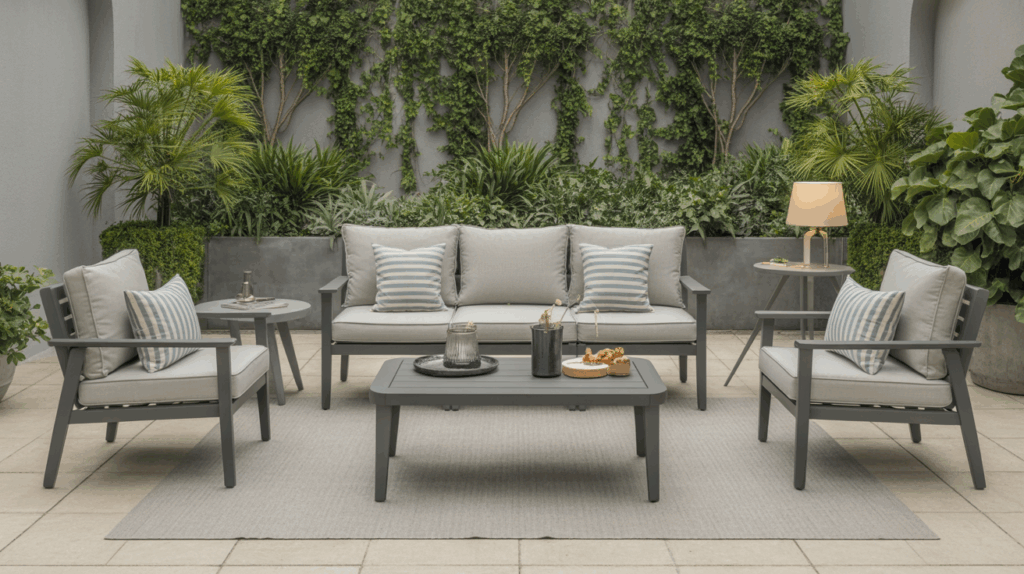
Color and Texture: Creating a Calm Palette
A calm palette rests on selecting gentle colors that feel dimensional yet restrained, so you’ll notice serenity rather than competition. Embrace natural texture elements—woven fibers, weathered wood, and stone—so tactile depth reinforces quiet elegance. Pair harmonious materials with mindful contrasts, letting subtle hues and textures guide your seating’s mood and cohesion.
Calm Color Schemes
Calm color schemes hinge on soft, nature-inspired hues that breathe serenity into outdoor spaces, while textures—grain, matte finishes, and subtle patterning—underpin the quiet feel without shouting. You’ll choose a restrained palette: pale greens, blues, taupes, and off-whites, allowing garden art to anchor focal points without dominance. Introduce contrast with texture rather than color: brushed metals, linen-like fabrics, and lightly weathered wood. For storage, select outdoor storage pieces in muted tones that blend into the backdrop, preserving calm. Use color to guide rhythm: repeat a single accent across cushions, planters, and art, maintaining cohesive balance.
Natural Texture Elements
Texture is the hinge between color and atmosphere, so weave tactile elements that echo your calm palette—think driftwood, linen, and weathered metal. You’ll select textures that read as quiet anchors, balancing soft fabrics with rugged surfaces. Consider garden sculptures and outdoor artwork as focal notes that echo, not compete with, your palette. Favor restrained patterns and natural fibers that age gracefully, avoiding reflectivity that disrupts serenity. Pair matte finishes with understated sheen to maintain cohesion. Introduce subtle contrast through grain, weave, and patina, ensuring each piece contributes to a cohesive, breathable environment without visual noise. Your space remains calm, cohesive, refined.
Harmonious Material Pairings
When harmonizing materials, pair soft textiles with weathered surfaces to weave a quiet, cohesive mood; think linen with driftwood or aged metal, where each element supports the palette without competing for attention. You’ll cultivate botanical harmony by selecting textures that read as a single field, not a collage. Embrace material contrast: avoid near-saturated tones beside loud patterns, favor restrained color blocking and tactile variance. Subtle shifts—matte versus gloss, rugged weave beside smooth slab—create depth without distraction. This disciplined pairing clarifies space, enhances comfort, and invites lingering, intentional conversation around your outdoor seating area.
Layering Shade: Strategies for Sun and Heat Relief
Layering shade is a deliberate craft: start with a light, permeable canopy to break the sun’s glare, then layer denser elements to reduce heat buildup without sacrificing airflow.
- Combine high-elevation sails with vertical shading, aligning sun angles for steady protection
- Use shaded screens, lattices, or pergolas to create cool pockets and promote air movement
- Add reflective or light-colored surfaces to reflect heat while maintaining visual harmony
This approach emphasizes layering shade, sun protection, and a refined outdoor experience, ensuring comfort without clutter. Precision in placement preserves sightlines, while aesthetics keep the space inviting and calm.
Seating Ergonomics and Cushion Comfort
You’ll want chairs that support natural seating posture, emphasizing ergonomic principles from thigh support to spine alignment. Cushion comfort hinges on density, breathability, and appropriate layering to reduce pressure points while maintaining a sleek, understated look. With adjustable support options, you can tailor height, tilt, and lumbar comfort to match any body and any outdoor setting.
Ergonomic Seating Principles
Ergonomic seating hinges on alignment, support, and comfort working in harmony so you can sit for longer without strain. You’ll notice how posture, seat depth, and backrest angle guide balance between ease and alertness, enhancing enjoyment of outdoor spaces. Focus on subtle contours that cradle your body while remaining lightweight in design; this is where garden design and outdoor furniture meet function and beauty.
- Align chair height with your knees for ideal circulation
- Choose cushions with adaptive support and breathable covers
- Test back support that encourages a natural spine curve
Cushion Comfort Essentials
Cushion comfort is about marrying support with airiness, so your outdoor seating stays inviting without sacrificing posture. You’ll select dense-density foam cores and breathable covers that resist moisture, fading, and sag over time. Prioritize seat depth and pillow height that align with your body, keeping knees and hips comfortable during lingering conversations. Consider Quick-dry fabrics and removable, wipeable upholstery for practical care. Pair cushions with subtle decorative accents—trim, piping, or textures—that elevate visual calm without clutter. For outdoor dining, combine color restraint with tactile variety to maintain elegance. Maintain even distribution of weight to avoid pressure points and fatigue.
Adjustable Support Options
Adjustable support options blend adaptability with enduring comfort, letting you tailor seating to body every move. You’ll feel the difference when cushions and backrests adjust to posture, promoting spine alignment and reduced fatigue. In outdoor settings, durable mechanisms keep performance reliable while maintaining clean aesthetics. Focus on intuitive controls, gradual adjustments, and stable supports to prevent snagging or strain. Pair with breathable fabrics to sustain temperature comfort and prolong cushion life. Your seating becomes a precise tool for relaxation, not a rigid constraint.
- adjustable support options
- flexible seating
- ergonomic customization
Layout Principles for Relaxed Social Flow
To foster relaxed social flow outdoors, arrange seating in intimate clusters that invite conversation without crowding. You should prioritize sightlines and accessibility, ensuring chairs and benches create natural pockets rather than rigid rows. Focus on furniture arrangement that encourages eye contact, while leaving clear paths for circulation. Balance pairings and groups to accommodate different group sizes, and position seating to face shared focal points without forcing everyone to group in one corner. Maintain thoughtful traffic flow by designing gentle, intuitive routes around plantings, paths, and features. This precision approach supports calm gatherings and effortless, unhurried interactions.
Greenery and Natural Elements That Quiet the Space
Greenery and natural elements quietly frame Outdoor Seating, turning the space into a softer, more inviting refuge. You’ll notice how plants soften edges, reduce noise, and invite lingering. Choose structure, texture, and scale to maintain balance while guiding flow. Use greenery to frame views, define zones, and soften hard surfaces. Garden pathways connect seating with shade, scent, and shelter, enhancing calm. Integrate outdoor art as quiet anchors rather than focal points, so visuals support, not compete. Practical choices matter: low maintenance, seasonal interest, and safe placement.
- garden pathways that invite slow, reflective movement
- strategic greenery to frame seats and suppress noise
- outdoor art that complements, not competes with, nature
Lighting or Ambiance That Encourages Slower Moments
Lighting sets the pace of the space, guiding footsteps and slowing breaths with quiet, intentional glow. You shape ambiance by evaluating solar placement, aligning shade and light with seating patterns so pauses feel natural, not forced. Use subtle contrasts—warm, low-intensity sources near seating, cooler, indirect accents elsewhere—to invite lingering. Integrate outdoor fire features as focal points for calm, not drama; position them to avoid glare while encouraging soft eye contact and conversation. Balance illumination with darkness in progressions from day to night, ensuring safety without harsh brightness. This precision elevates relaxation, supporting slower moments without demanding attention.
Subtle Boundaries and Noise Reduction Techniques
Subtle boundaries and noise reduction hinge on thoughtful placement and restrained detail. You’ll create calm by choosing screens and textures that soften sound without shouting design. Focus on simple forms, natural materials, and strategic distances to minimize echo and chatter.
- sound masking cues integrated into the environment
- visual screening that preserves openness while offering privacy
- textural variety to dampen footsteps and voices
Choose plants, fabric, and fences that absorb, not amplify, then test at different times of day. Your goal: a subtle, cohesive backdrop where conversations feel private but not cloistered, and external noise fades into the background, letting guests linger with ease.
Conclusion
You’ll finish with a retreat that breathes ease. Choose weather-ready materials that endure, then layer soft textures and calm colors to soothe the eye. Shade matters as much as sun, so craft a plan that cools without crowding. Ergonomics and cushions invite lingering, while thoughtful layouts nurture relaxed chatter. Integrate greenery and natural elements for quiet depth, and gentle lighting that slows the moment. Subtle boundaries and careful acoustics seal the sense of sanctuary. Your outdoor seating becomes a mindful haven.
